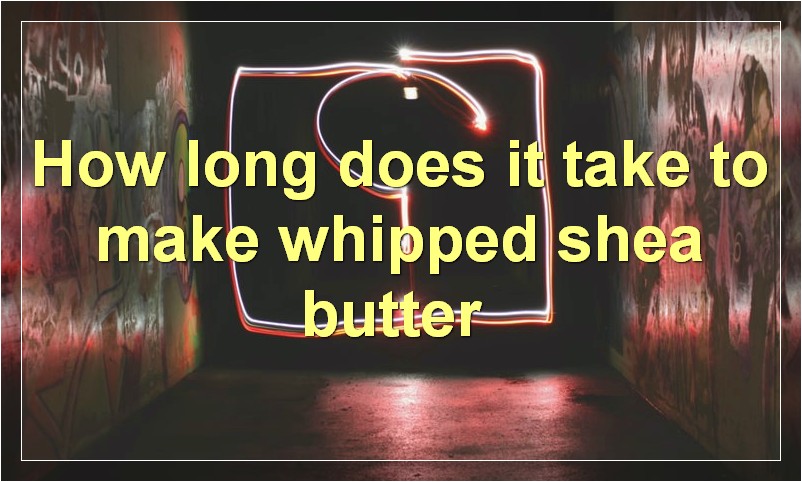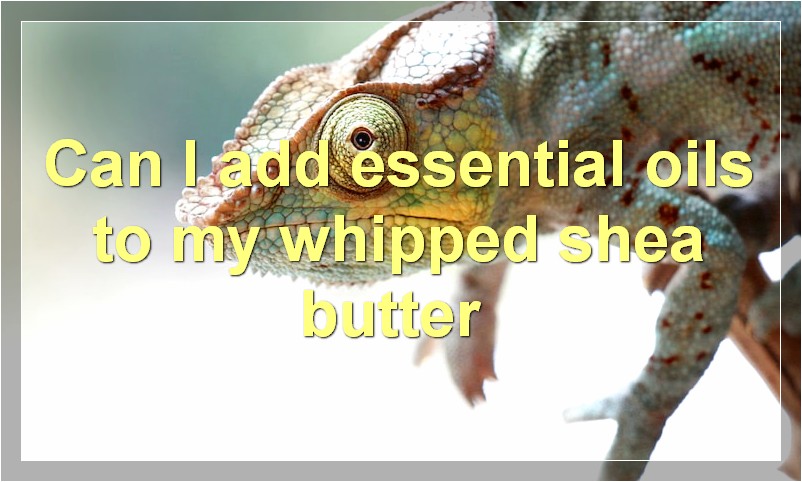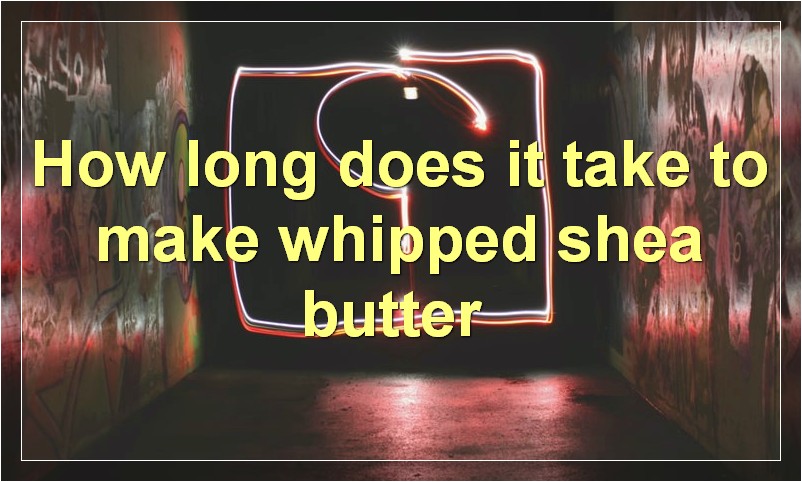If you’re looking for a luxurious, all-natural alternative to store-bought body lotions, look no further than whipped shea butter!
How long does it take to make whipped shea butter?

Whipped shea butter is a versatile product that can be used for a variety of purposes, from moisturizing your skin to adding shine to your hair. But how long does it take to make this magical concoction?
The answer depends on a few factors, including the type of shea butter you’re using and the method you’re using to whip it. If you’re using raw shea butter, you’ll need to melt it down before you can start whipping it. This can be done in a double boiler or in the microwave. Once the shea butter is melted, you can add any essential oils or other ingredients you want to include in your whipped shea butter.
Once your ingredients are all mixed together, it’s time to start whipping! You can use an electric mixer, a stand mixer, or even a hand mixer to get the job done. Start on low speed and gradually increase the speed as the mixture starts to come together. The goal is to get a light and fluffy consistency, so don’t overdo it or you’ll end up with more of a buttery paste than a whipped cream.
Depending on the method you’re using and the size of your batch, it can take anywhere from 5 minutes to 30 minutes to get the perfect whipped shea butter consistency. So now that you know how long it takes to make whipped shea butter, what are you waiting for? Get whipping!
What are the benefits of using whipped shea butter?
Whipped shea butter is a type of moisturizer that is made from the nut of the African shea tree. It has been used for centuries in Africa for its skin-healing properties. The butter is rich in vitamins A and E, as well as essential fatty acids and other nutrients that are beneficial for the skin.
Whipped shea butter has a light, creamy texture that is easy to spread on the skin. It melts quickly into the skin, providing deep hydration. Unlike some other types of moisturizers, whipped shea butter does not clog pores or leave behind a greasy residue.
Whipped shea butter can be used to treat a variety of skin conditions, including eczema, psoriasis, and dermatitis. It can also be used as a general body lotion to prevent dry skin. When used regularly, whipped shea butter can help to improve the overall appearance of the skin by reducing wrinkles, fine lines, and age spots.
Is there a certain time of day that is best to use whipped shea butter?
If you want to get the most out of your whipped shea butter, then using it at night before bed is the best option. This is because your skin will have time to absorb all of the nutrients and moisture from the shea butter while you sleep, so you’ll wake up with soft, glowing skin.
But if you don’t have time for a long beauty routine at night, don’t worry – you can still reap the benefits of whipped shea butter by using it in the morning. Just apply a thin layer after your shower or cleansing routine, and you’ll be all set for the day ahead with hydrated, healthy skin.
No matter when you use it, though, make sure to enjoy the process of applying whipped shea butter to your skin. It’s not only good for your skin, but it’s also a great way to relax and pamper yourself. So take your time, and enjoy the luxurious feeling of this amazing natural product!
How long will a batch of whipped shea butter last?
Assuming you are referring to unrefined, raw shea butter, straight from the nut, it will last approximately 18 months to 2 years. If you are referring to a whipped version of shea butter, it will have a shorter lifespan due to the addition of water and air during the whipping process. Once opened, all types of shea butter should be stored in a cool, dark place to maintain optimal freshness.
Raw, unrefined shea butter is solid at room temperature but melts into an oil when warmed. It can be used as-is or whipped into a lighter, fluffier consistency. Whipping shea butter introduces air and water into the mix, which makes it less shelf-stable than its unwhipped counterpart.
Most people find unrefined shea butter to be too heavy and greasy for use as-is, especially on the face. However, many people enjoy using unrefined shea butter in hair treatments or as a body moisturizer. Those with dry skin may also prefer unrefined shea butter because it is more hydrating than the whipped version.
Whipped shea butter is a popular choice for body lotions and creams because it is light enough to spread easily and absorbs quickly into the skin. It is also often used as a hair conditioner or scalp treatment. While whipped shea butter has a shorter shelf life than unrefined shea butter, it is still quite long-lasting when stored properly. An opened jar of whipped shea butter will last for 6 to 12 months.
To extend the shelf life of your shea butter, store it in a cool, dark place away from heat and direct sunlight. Shea butter does not need to be refrigerated but storing it in the fridge can help it last even longer. Be sure to tightly close the lid on your shea butter container to keep out moisture and contaminants.
Can I add essential oils to my whipped shea butter?

Yes, you can add essential oils to your whipped shea butter! There are a few things to keep in mind when doing so, but it’s generally a pretty simple process.
First, it’s important to choose the right essential oil. Some oils are more potent than others, so you’ll want to make sure you pick one that complements the other ingredients in your shea butter. You’ll also want to make sure the oil is safe for topical use.
Once you’ve chosen an oil, you’ll need to figure out how much to add. This will vary depending on the oil you’re using and your personal preference. Start with a small amount and increase it until you find the perfect balance.
Once you’ve added the essential oil, simply mix everything together until it’s well combined. That’s all there is to it! Your whipped shea butter will now have a lovely scent and some additional benefits.
What type of container is best to store my whipped shea butter in?
When it comes to storing your whipped shea butter, there are a few things you need to take into consideration. The first is the type of container you store it in. There are a variety of containers that can be used to store whipped shea butter, but not all of them are created equal. The best type of container to use is one that is airtight and made of glass or plastic. This will help to keep the whipped shea butter fresh and free from contaminants.
The second thing you need to take into consideration is how much whipped shea butter you plan on storing. If you only plan on storing a small amount, then a smaller container will suffice. However, if you plan on storing a large amount, then you will need a larger container. The size of the container you use will also affect how long the whipped shea butter will last.
Once you have taken these factors into consideration, you can then choose the best type of container to store your whipped shea butter in. Glass or plastic containers that are airtight are the best option for keeping your whipped shea butter fresh and free from contaminants.
Should I refrigerate my whipped shea butter?
Assuming you’re referring to store-bought whipped shea butter, the answer is no, you don’t need to refrigerate it. However, if you made your own whipped shea butter at home, it’s best to keep it in the fridge since it doesn’t have preservatives. Whipped shea butter will last longer unrefrigerated, but it will last even longer if you do refrigerate it.
What are some common uses for whipped shea butter?
Whipped shea butter is a versatile product that can be used for a variety of purposes. Here are some of the most common uses for this natural wonder:
1. Moisturizing dry skin: Whipped shea butter makes an excellent moisturizer for dry skin. It’s rich in fatty acids and vitamins A, E, and F, which are all essential for maintaining healthy skin. Simply apply it to your skin after bathing or showering and enjoy softer, smoother skin.
2. Soothing irritated skin: Whipped shea butter can also be used to soothe irritated skin. The fatty acids in shea butter help to reduce inflammation and redness, while the vitamin E provides antioxidant protection. Apply it to sunburns, insect bites, or other irritated areas of skin for instant relief.
3. Nourishing hair: In addition to being good for your skin, whipped shea butter is also great for your hair. It can help to nourish and condition dry, damaged, or brittle hair. Massage it into your scalp and hair before shampooing, or use it as a leave-in conditioner for extra moisture.
4. Protecting against stretch marks: Stretch marks are a common problem during pregnancy, but they can also occur due to weight gain or loss. Whipped shea butter can help to prevent and reduce the appearance of stretch marks by keeping the skin supple and hydrated. Apply it liberally to your stomach, breasts, hips, and buttocks during pregnancy (or whenever you expect your body to change shape).
5. Healing cracked heels: Cracked heels are not only unsightly, but they can also be painful. Fortunately, whipped shea butter can help to heal cracked heels and keep them soft and smooth. Simply massage it into your feet before bedtime and cover with socks overnight. In the morning, your feet will feel much better!
How do I know if my whipped shea butter is bad?
Whipped shea butter is a popular natural product used to moisturize and protect the skin. Despite its popularity, there is still some confusion surrounding how to properly store and use this product. One common question is “How do I know if my whipped shea butter is bad?”
There are a few telltale signs that your whipped shea butter has gone bad. If the texture has changed from creamy and smooth to grainy and clumpy, this is a sign that the butter has oxidized and is no longer fresh. Another way to tell if your shea butter has gone bad is by its smell; if it has developed an off-putting smell, it is no longer good to use. Finally, if the color of the butter has changed from its original white or ivory color to a yellow or brown shade, this means that it has been exposed to too much heat or light and is no longer effective.
If you notice any of these changes in your whipped shea butter, it is best to discard it and purchase a new batch. Whipped shea butter can last for several months when stored properly, but once it goes bad, it will not improve with time. To extend the shelf life of your shea butter, be sure to store it in a cool, dark place away from direct sunlight.




